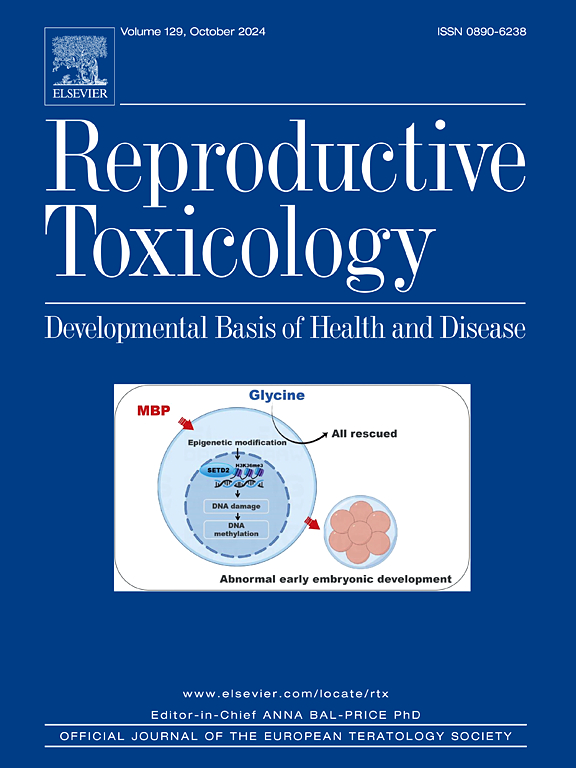Prenatal exposure to phenanthrene impairs spermatogenesis and fertility by elevating apoptosis, altering gene expression, and disrupting steroidogenesis in adult male mice across two generations
IF 3.3
4区 医学
Q2 REPRODUCTIVE BIOLOGY
引用次数: 0
Abstract
Background
Phenanthrene, a polycyclic aromatic hydrocarbon, can enter the human body via various routes and affect reproductive health. Its low molecular weight enables its transfer from the mother to the fetus. However, comprehensive research on its effects on reproductive system development is lacking. This study aimed to examine the impacts of prenatal phenanthrene exposure on the reproductive systems of both the immediate offspring and their progeny.
Methods
Pregnant mice were divided into three groups: control, sham, and phenanthrene. From the detection of the vaginal plug until pregnancy day 18, mice in the phenanthrene group were administered phenanthrene solution (60 μg/kg), while sham mice received corn oil on alternate days. Following birth, male offspring were maintained without intervention until PND56. After puberty, a portion of these males were bred, while others were euthanized for histological and molecular analyses. The subsequent generation was born and developed under standard conditions without intervention, and underwent procedures similar to those of the first generation.
Results
The study revealed that exposure to phenanthrene during fetal development, across two consecutive generations, led to a reduction in the expression of genes associated with mitosis and meiosis, while simultaneously increasing the rate of cell death. Additionally, the research found that a decline in Leydig cells resulted in decreased serum testosterone levels, which subsequently led to diminished quality and quantity of sperm.
Conclusion
Prenatal phenanthrene exposure, by disrupting gene expression and steroidogenesis, causes impaired testicular tissue function, reduced spermatogenesis, and ultimately reduced male fertility rates in the F1 and F2.
在两代成年雄性小鼠中,产前暴露于菲通过增加细胞凋亡、改变基因表达和破坏类固醇生成来损害精子发生和生育能力。
背景:菲是一种多环芳烃,可通过多种途径进入人体,影响生殖健康。它的低分子量使其能够从母亲转移到胎儿。然而,其对生殖系统发育的影响尚缺乏全面的研究。本研究旨在探讨产前接触菲对直系后代及其后代生殖系统的影响。方法:将妊娠小鼠分为对照组、假药组和菲菲组。从阴道塞检测到妊娠第18天,菲组小鼠给予菲溶液(60μg/kg),假药组小鼠隔天给予玉米油。出生后,雄性后代在没有干预的情况下一直维持到PND56。在青春期后,这些雄性中的一部分被繁殖,而其他的则被安乐死以进行组织学和分子分析。下一代在没有干预的情况下在标准条件下出生和发育,并经历与第一代相似的程序。结果:研究表明,在连续两代的胎儿发育过程中,暴露于菲会导致与有丝分裂和减数分裂相关的基因表达减少,同时增加细胞死亡率。此外,研究还发现,间质细胞的减少会导致血清睾酮水平下降,从而导致精子的质量和数量下降。结论:产前菲暴露通过破坏基因表达和甾体生成,导致睾丸组织功能受损,精子发生减少,最终降低雄性F1和F2的生育率。
本文章由计算机程序翻译,如有差异,请以英文原文为准。
求助全文
约1分钟内获得全文
求助全文
来源期刊

Reproductive toxicology
生物-毒理学
CiteScore
6.50
自引率
3.00%
发文量
131
审稿时长
45 days
期刊介绍:
Drawing from a large number of disciplines, Reproductive Toxicology publishes timely, original research on the influence of chemical and physical agents on reproduction. Written by and for obstetricians, pediatricians, embryologists, teratologists, geneticists, toxicologists, andrologists, and others interested in detecting potential reproductive hazards, the journal is a forum for communication among researchers and practitioners. Articles focus on the application of in vitro, animal and clinical research to the practice of clinical medicine.
All aspects of reproduction are within the scope of Reproductive Toxicology, including the formation and maturation of male and female gametes, sexual function, the events surrounding the fusion of gametes and the development of the fertilized ovum, nourishment and transport of the conceptus within the genital tract, implantation, embryogenesis, intrauterine growth, placentation and placental function, parturition, lactation and neonatal survival. Adverse reproductive effects in males will be considered as significant as adverse effects occurring in females. To provide a balanced presentation of approaches, equal emphasis will be given to clinical and animal or in vitro work. Typical end points that will be studied by contributors include infertility, sexual dysfunction, spontaneous abortion, malformations, abnormal histogenesis, stillbirth, intrauterine growth retardation, prematurity, behavioral abnormalities, and perinatal mortality.
 求助内容:
求助内容: 应助结果提醒方式:
应助结果提醒方式:


